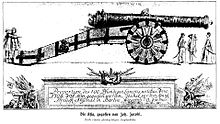Royal foundry

The electoral, later royal, foundry house in Berlin was built in 1645 on the orders of Elector Friedrich Wilhelm . The foundry manufactured a large part of the artillery used in the Old Prussian Army (1644–1806) . In 1872 the building was demolished.
A half-timbered building on the Friedrichswerder
Because of its fire hazard, the foundry was built outside of the former Berlin city walls in an originally almost uninhabited area in the northern part of the area later known as Friedrichswerder . As can be seen in old pictures, the half-timbered building was also surrounded by a protective earth wall. It was located in the immediate vicinity of an arm of the Spree, which enabled deliveries and transport of finished products by water.
The street name “Hinter dem Gießhaus” on the north side of the former property still reminds of this building.
New building by Andreas Schlueter
According to a design by Andreas Schlüter , the casting house was rebuilt in solid masonry between 1698 and 1699. A redesign and modernization of the entire plant had become necessary in order to equip the casting house for the larger tasks that it was to perform in the nascent Kingdom of Prussia. The armory was built close by - also under the construction management of Andreas Schlüter. The foundry may have had a major impact on the decision made in 1691 for the location of the armory. The new guns could now be transported to the immediately adjacent arsenal by the shortest route.
Cannons and statues

Almost all Prussian guns were in Berlin in the behind the armory made Gießhaus located. From July 1743 gun barrels were also cast in Breslau and, to a lesser extent, in Vietz in New Markia . The copper used for production came from Rothenburg an der Saale , the tin was imported from Cornwall . In addition to its military purpose, the Royal Casthouse also performed civilian tasks, such as casting statues and bells .
Among the numerous foundries working at the Berlin foundry house, Johann Jacobi should be emphasized, who worked as a royal court and artillery caster at the Berlin foundry house from 1697 until his death in 1726. He cast Andreas Schlüter's monumental sculptures such as the equestrian statue of the Great Elector in 1700 (today in front of Charlottenburg Palace). In 1704 he manufactured the 17.5-ton, hundred-pound pomp " Asia " gun , which was less used than to represent the Prussian state.
Production figures from 1698 to 1786
| Protection type | 1698 to 1740 | 1741 to 1762 | 1763 to 1786 |
|---|---|---|---|
| without caliber | 46 | 0 | 0 |
| Metal cannons (3-24 pounds) | 466 | 862 | 1011 |
| Howitzers (7-30 pounds) | 8th | 118 | 219 |
| mortar | 71 (+ 302 hand mortars) | 42 | 42 |
Demolished in 1872
The foundry was demolished in 1872: an architectural loss that experts have lamented. An armory depot was created on the site.
See also
literature
- Elke Bujok, Peter Fuchs: The casting house on Friedrichswerder. In: Communications from the Association for the History of Berlin . 93, 1997, pp. 278-289.
- Martin Guddat : Gunner, Bombardier, Pontonier. The artillery of Frederick the Great . Mittler & Sohn publishing house, Bonn 1992, ISBN 3-8132-0383-2 .
- Guido Hinterkeuser: The Berlin Palace. The renovation by Andreas Schlueter. Siedler Verlag, Berlin 2003. ISBN 3-88680-792-4 .
- Uwe Michas: The royal casting house in Berlin. In: The Mark Brandenburg . Issue 91, 2013 / IV. Marika Groszer Verlag Berlin. ISBN 978-3-910134-65-2 .
- Erika Schachinger: The Berlin suburb Friedrichswerder 1658–1708. Verlag Böhlau, Cologne 1993, ISBN 3-412-13992-0 .
- Franz Weinitz : Johann Jacobi. The founder of the equestrian monument of the Great Elector in Berlin. His life and his work. Berlin 1914.
Individual evidence
- ↑ Behind the foundry house. In: Street name lexicon of the Luisenstädtischer Bildungsverein (near Kaupert )
- ↑ Guido Hinterkeuser: The Berlin Palace. The renovation by Andreas Schlueter. Siedler Verlag, Berlin 2003. ISBN 3-88680-792-4 , p. 47.
- ↑ Elke Bujok, Peter Fuchs: The casting house on Friedrichswerder. In: Mitteilungen des Verein für die Geschichte Berlins , 1997, p. 288.
- ↑ Martin Guddat: Gunner Bombardier Pontoniere. The artillery of Frederick the Great . Verlag Mittler & Sohn, Bonn 1992, pp. 87-89.
Coordinates: 52 ° 31 '4 " N , 13 ° 23' 49" E

